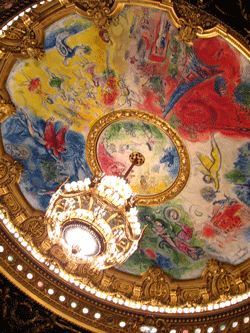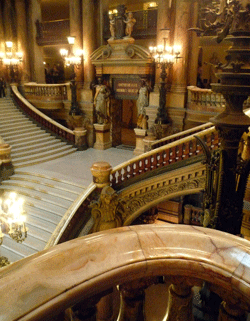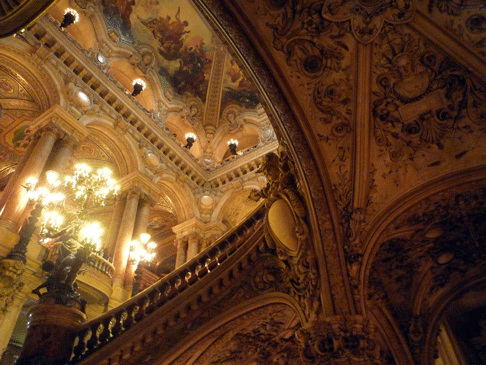Non-aficionados of the opera are familiar with the
1,900 plus-seat landmark theater. Tourists are in awe by its fine example of
Beaux-Arts. The Palais Garnier is a prime stop on numerous sightseeing
tours.
 Chandelier at the Palais Garnier [Photo by Minor Keys]
Chandelier at the Palais Garnier [Photo by Minor Keys]
Even those who never visited the “City of Light” are acquainted
with the Palais Garnier through Gaston Leroux’s Phantom of the
Opera, written in 1910.
Leroux was a frequent visitor and explored the backstage areas and inner
sanctions. One tragedy aided in his literary work, and Leroux took poetic
license in his novel, when a portion of a chandelier fell and killed one of the
opera patrons.
The Palais Garnier has gone through several name changes since its opening.
Many simply refer to it as the Paris OpÈra.
The Palais Garnier’s history began as part of the great improvement
projects instrumented by Napoleon III and Baron Georges-EugËne Haussmann.
Napoleon III formulated a competition in search of an architect to design the
structure to rival any of the existing opera houses in Italy.
 The Grand Stair [Photo by Steven Zucker]
The Grand Stair [Photo by Steven Zucker]
Charles Garnier, a relatively unknown with limited on-hands experience, was
awarded the project in 1860. Construction was disrupted by various incidences,
including the back up of water from the aquifer, lack of funding, the
Franco-Prussian War and the demise of Napoleon III’s Empire.
The incomplete structure was used in part as a storage warehouse for food
supplies. Residents wanted it to be demolished since it represented a fallen
empire.
Garnier persevered and continued by utilizing new techniques to architecture
design. He disliked metal but knew he needed to use these materials in the
building’s construction. However, he carefully concealed the metal from
view. For cost saving measures, he used the innovative “gilding
effect” to replace traditional gold leaves.
When finally launched 15 years later, Fromental HalÈvy’s La
Juive was the inaugural production on January 5th, 1875 . Audiences noted
all the ornamental detailing, including sculptures the renowned composers
ablaze in bronze and paintings illustrating musical symbols. Equally
compelling, the Grand Staircase, which leads into the multi-level theater, is a
show-stopping feature measured by its marble of various hues.
 The Grand Stair from Below [Photo by Steven Zucker]
The Grand Stair from Below [Photo by Steven Zucker]
At the entrance, immense mirrors allow patrons to become a part of the
building’s interior dÈcor. The vast and richly decorated foyers set the
audience’s stage with pleasing scenes to stroll through during
intermission.
The fortitude of creativity Charles Garnier shown in his design of the
Palais Garnier served as a prototype for other worldwide structures. Examples
include The Juliusz Slowacki Theatre in Krakow, Theatro Municipal do Rio de
Janeiro, The Jefferson Building in Washington D.C., and National Opera House of
Ukraine in Kiev.
Charles Garnier’s ultimate determination was to make the Palais
Garnier a palace. Unquestionably he succeeded in his goal.
Veronica Shine
Planning a Visit:
The Palais Garnier is located on 281 Rue Saint-Denis in the district known
as the Place de l’OpÈra in the 9th arrondissement.
If driving, there is parking at Place VendÙme.
The venue is best reached via Paris’s fine public transportation.
By MÈtro: Board line nos. 3, 7, 8 to station OpÈra
By RER: The regional “A” train closest station is Auber
By Bus: Ride any bus numbered 20, 21, 22, 27, 29, 42, 52, 53, 66, 6 8, 81, 95
directly to the Palais Garnier
The schedule for performances and events are at the OpÈra national de Paris’ web site, which also provides a virtual tour of Palais Garnier. Additional nformation on performances and tours is available at the Palais Garnier’s box office, which is open Monday to Saturday from 10:30am to 6:30pm.
Find accommodations near the Palais Garnier at Parishotels.net or search for something
with more elbow room with a holiday apartment at holidayapartments.net.
image=http://www.operatoday.com/Palais_Garnier.gif
image_description=Facade of Le Palais Garnier
product=yes=
product_title=The Opera House that Almost Wasn’t — Le Palais Garnier in Paris
product_by=By Veronica Shine
product_id=Above: Facade of Le Palais Garnier
The Opera House that Almost Wasn’t — Le Palais Garnier in Paris
Non-aficionados of the opera are familiar with the
1,900 plus-seat landmark theater. Tourists are in awe by its fine example of
Beaux-Arts. The Palais Garnier is a prime stop on numerous sightseeing
tours.
Even those who never visited the “City of Light” are acquainted
with the Palais Garnier through Gaston Leroux’s Phantom of the
Opera, written in 1910.
Leroux was a frequent visitor and explored the backstage areas and inner
sanctions. One tragedy aided in his literary work, and Leroux took poetic
license in his novel, when a portion of a chandelier fell and killed one of the
opera patrons.
The Palais Garnier has gone through several name changes since its opening.
Many simply refer to it as the Paris OpÈra.
The Palais Garnier’s history began as part of the great improvement
projects instrumented by Napoleon III and Baron Georges-EugËne Haussmann.
Napoleon III formulated a competition in search of an architect to design the
structure to rival any of the existing opera houses in Italy.
Charles Garnier, a relatively unknown with limited on-hands experience, was
awarded the project in 1860. Construction was disrupted by various incidences,
including the back up of water from the aquifer, lack of funding, the
Franco-Prussian War and the demise of Napoleon III’s Empire.
The incomplete structure was used in part as a storage warehouse for food
supplies. Residents wanted it to be demolished since it represented a fallen
empire.
Garnier persevered and continued by utilizing new techniques to architecture
design. He disliked metal but knew he needed to use these materials in the
building’s construction. However, he carefully concealed the metal from
view. For cost saving measures, he used the innovative “gilding
effect” to replace traditional gold leaves.
When finally launched 15 years later, Fromental HalÈvy’s La
Juive was the inaugural production on January 5th, 1875 . Audiences noted
all the ornamental detailing, including sculptures the renowned composers
ablaze in bronze and paintings illustrating musical symbols. Equally
compelling, the Grand Staircase, which leads into the multi-level theater, is a
show-stopping feature measured by its marble of various hues.
At the entrance, immense mirrors allow patrons to become a part of the
building’s interior dÈcor. The vast and richly decorated foyers set the
audience’s stage with pleasing scenes to stroll through during
intermission.
The fortitude of creativity Charles Garnier shown in his design of the
Palais Garnier served as a prototype for other worldwide structures. Examples
include The Juliusz Slowacki Theatre in Krakow, Theatro Municipal do Rio de
Janeiro, The Jefferson Building in Washington D.C., and National Opera House of
Ukraine in Kiev.
Charles Garnier’s ultimate determination was to make the Palais
Garnier a palace. Unquestionably he succeeded in his goal.
Veronica Shine
Planning a Visit:
The Palais Garnier is located on 281 Rue Saint-Denis in the district known
as the Place de l’OpÈra in the 9th arrondissement.
If driving, there is parking at Place VendÙme.
The venue is best reached via Paris’s fine public transportation.
The schedule for performances and events are at the OpÈra national de Paris’ web site, which also provides a virtual tour of Palais Garnier. Additional nformation on performances and tours is available at the Palais Garnier’s box office, which is open Monday to Saturday from 10:30am to 6:30pm.
Find accommodations near the Palais Garnier at Parishotels.net or search for something
with more elbow room with a holiday apartment at holidayapartments.net.
image=http://www.operatoday.com/Palais_Garnier.gif
image_description=Facade of Le Palais Garnier
product=yes=
product_title=The Opera House that Almost Wasn’t — Le Palais Garnier in Paris
product_by=By Veronica Shine
product_id=Above: Facade of Le Palais Garnier